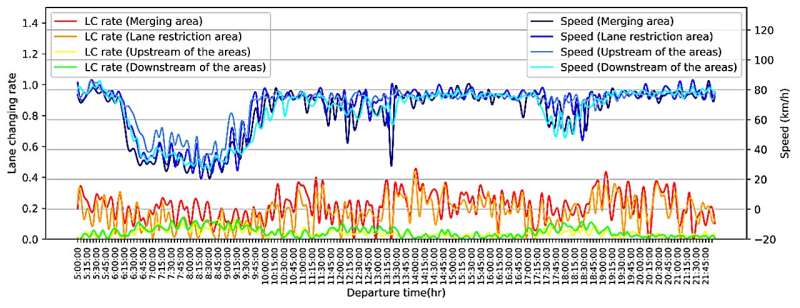This article has been reviewed according to Science X's editorial process and policies. Editors have highlighted the following attributes while ensuring the content's credibility:
fact-checked
proofread
Lane changing and congestion found to be mutually reinforcing

As drivers pursue a better driving environment, they perform lane changes to get out of the currently congested lane. But changing lanes can also disrupt or even interrupt traffic flow, leading to worsening congestion. Is there a mutually reinforcing relationship between lane changing and congestion?
In a new paper, a team comprehensively analyzed the relationship between congestion and lane changes from individual and systemic perspectives at different times and spaces based on trajectory data from the M1 motorway, which is a major arterial road in Sydney, Australia.
They published their study on in Communications in Transportation Research.
Based on the trajectory data from the M1 motorway, the researchers establish a connection between the distribution of travel time and lane changing frequency and employ a Poisson process to describe the intensity of lane changing occurrences in different travel time ranges. The result indicates that there is a positive correlation between lane changing frequency and the extent of congestion.
From an individual perspective, lane changing does not bring significant speed benefits in most cases, except when the speed range is between 45 km/h and 50 km/h.
From a systems perspective, the relationship between lane change rate and speed depends on the purpose of the lane changes. In merging, diverging, and lane restriction areas, for instance, mandatory lane changes dominate. In most sections of the motorway, discretionary lane changes are motivated by the expectation of improving speed and/or safety.
Additionally, the team demonstrates a mutual causality relationship between lane changing and congestion through the Granger causality test. This relationship is more pronounced in general areas during peak periods and contributes to the deterioration of the driving environment.
During more congested peak periods and in more prevalent general areas, the decline in driving speed due to congestion and speed disturbances increases the likelihood of drivers engaging in lane changes. In turn, a higher lane changing rate interrupts traffic flow and slows down vehicles in the vicinity of the lane change, perpetuating the overall speed degradation.
This insight informs congestion management policies, suggesting that general areas during peak congestion should discourage lane changes. By doing so, the mutual reinforcement leading to continuous deterioration of driving conditions may be mitigated, ultimately improving overall motorway performance.
More information: Yang Gao et al, Lane changing and congestion are mutually reinforcing?, Communications in Transportation Research (2023). DOI: 10.1016/j.commtr.2023.100101



















